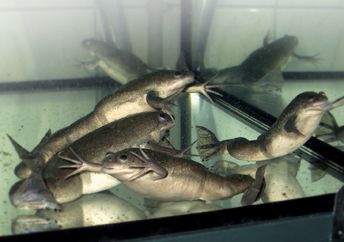

Projects in progress
COST action
Since 2016 - member of Management Committee and participant of COST action: EuroCellNet, CA 15211 "An integrative action for multidisciplinary studies on cellular structural networks”
Role of lamins phosphorylation sites in lamins function in vivo and in vitro at experimental model Drosophila melanogaster (In cooperation with Prof. P.A. Fischer, Department of Pharmacological Sciences, University Medical Center at Stony Brook, State University of New York at Stony Brook, USA)
In our study we focused on the identification of new phosphorylation sites in Drosophila melanogaster lamins in vivo which was followed by the analysis of their function. During our work we employed the tandem mass spectrometry (MS/MS) to identify phosphorylation sites on isolated lamins from embryos and Kc cells lysates D.melanogaster. We have prepared a set of point mutated lamin Dm and lamin constructs in which serine or threonine residue (known or predicted phosphorylation sites) was substituted by glutamic acid to mimic stable, permanent phosphorylation. All mutatnts were tested to establish whether introduced mutations exert influence on the ability of lamin to polymerize (sedimentation assay), chromatin interaction and proper protein structure (CD). To examine the effects of the prepared lamin phosphorylation mutants in living cells, we constructed plasmids, which provide overexpression of chimeric lamin Dm mutants as fusion proteins
with GFP.
The analysis of the molecular background of the Emery-Dreifuss muscular dystrophy type 1 (EDMD1).
Emery-Dreifuss muscular dystrophy type 1 (EDMD1, OMIM 310300) is a rare genetic disorder caused by many different mutations in the EMD gene coding for emerin. The aim of the project, which is currently carried out in the Laboratory of Nuclear Proteins, is to determine the molecular mechanism of this disease.
Thanks to cooperation with Dr. Agnieszka Madej-Pilarczyk from the Neuromuscular Unit, Mossakowski Medical Research Centre, Polish Academy of Sciences in Warsaw, Poland, we have obtained fibroblasts from patients affected by EDMD1. Skin biopsies from patients were obtained during the pacemaker replacement surgery in Warsaw, and then fibroblasts cell lines were derived in the Laboratory of Nuclear Proteins.
The effect of the mutations is mostly observed in muscle cells, including heart, which means that they are crucial for this tissue. Therefore, analyses of the molecular mechanism of this disease should be carried out on this type of cells. Muscle cells derived from biopsy have, unfortunately, a limited number of divisions, which does not allow for the analysis of the background of the disease, and multiple muscle biopsies from patients are not possible.
However, fibroblast cell lines derived from patients allow to generate induced pluripotent stem cells (iPSCs) from them and then differentiate them, among others, to myoblasts, myotubes or cardiomyocytes, thus obtaining material for the study of the background and the mechanism of EDMD1. We have already generated induced pluripotent stem cells (iPSCs) from fibroblasts from patients suffering from EDMD1 and from control fibroblasts, and then we plan to differentiate them to myoblasts, myotubes and cardyomyocytes, which will be a material for further research on the molecular mechanism of this disease. The project is carried out in cooperation with Dr. Claudia Bearzi and dr Giovanna Lattanzi at the National Research Council (CNR) laboratories in Milan and in Bologna in Italy.
Function of karyoskeleton proteins in nuclear envelope depolymerization and reassociating during mitosis. (In cooperation with Prof. C.J. Hutchison, Dr M.Goldberg, Integrative Cell Biology Laboratories, School of Biological and Biomedical Sciences, The University of Durham, UK)
Application of exogenous, nuclear-directed maspin in breast cancer treatment using combined gene therapy and liposome chemotherapy. (In cooperation with Dr M. Sopel, Department of Histology and Embryology, Wrocław Medical University)
Lamins localization and function in early developmental stages of D.melanogaster.
Projects and latest news:
European Meeting on Intermediate Filaments
Noordwijkerhout, The Netherlands
June 4 – 7, 2023
euro-if-2023.org
Noordwijkerhout, The Netherlands
June 4 – 7, 2023
euro-if-2023.org
COST Euro-Laminopathies for therapy of laminopathies and muscle related disorders, Wrocław, May 27-29 2019 link
